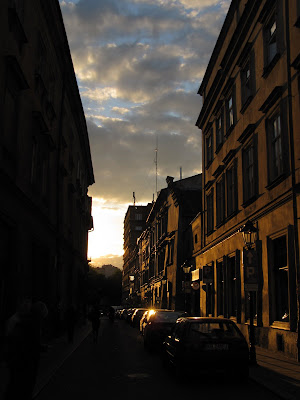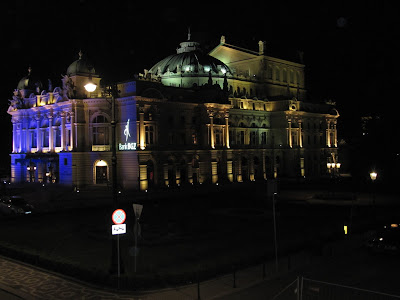We really enjoyed Cracow. It is relatively untouched from the World Wars allowing glimpses of the past as far back as 200,000 BC. Western tourism dollars have yet to really infilitrate the city making it a little less renovated than what we saw in Prague. That being said, most of the city was under construction and renovation while we were here. Given the shear beauty of the city as well as all the periods represented (prehistoric, Romanesque, Gothic, Renaissance, Boroque, and Medieval), I am sure that it will not be long before Cracow is "discovered".
We spent the majority of our time exploring Central Cracow, which includes the historic Old Quarter, Wawel Hill, as well as some of the surrounding quarters - in particular the Kazimierz Quarter.
OLD QUARTER: Market Square
Cracow's Market Square has been voted by the Project for Public Spaces (an American non-profit organization) as the best municipal square from their global list. We really enjoyed coming here to people watch and to hang out. Unfortunately places like this always attract those people trying to sell garbage - particularly annoying was one guy who sold little whistles for kids - when a group of children walked by you were gauranteed to hear endless racquet for the next 30 minutes. Thankfully the Market square is the largest market square in all of Europe (200m x 200m) so there was always plenty of space to relocate ourselves. I really enjoyed watching one guy who made large bubbles for the kids to play in.

Since every road in Central Cracow leads to the main market square we must have walked through it 5-10 times/day. Depending on the time of day the atmosphere of the square was completely different.
Typical streets in the Old Quarter leading away from the Market Square.


Statue of the poet Adam Mickiewicz. (Left-morning. Right - afternoon). We thought it was interesting how people just crawled all over this statue...don't mind the chain fence people!)


The Market square is dominated by the Church of St. Mary, which is (argueably) Cracow's most recognized feature. Every hour, after the bells ring, a bugle call is made from the high tower. In the picture above you will notice everybody's attention is to the tower during one of the bugle calls.

The church certainly provides a nice backdrop to a few drinks and relaxing.

In the center of the square is the cloth hall (left), which orginally was a covered market.

On the other side of the Cloth Hall is the Town Hall Tower. The Tower is the only remaining fragment of the Old Town Hall.

WAWEL HILL & THE CRACOW CATHEDRAL
This area is a "must-see" while in Cracow. The most ancient signs of life in Cracow, the Royal Residence, and the Cracow Cathedral are all found within the Wawel fortifications and towers. A "wawel" is a hill surrounded my marshes.
Now, I really had high expactations and wanted to enjoy their "first-class collections" on display, representing many different ages of the inhabitants, but found that I preferred to enjoy Wawel Hill from the outside and was rather bored or annoyed with the paid displays. Part of my annoyance may have been due to the fact that there were so many tour groups. I was never really allowed those quiet and intimate moments sometimes needed to appreciate some of the displays. The other part of my annoyance was I did not feel that you got what you paid for.
Cracow Cathedral (left) inside the fortifications and towers of Wawel Hill.


Me infront of the Sandomierz Tower - One of 3 Wawel Defense towers.


Jennie infront of the Cracow Cathedral.
CRACOW FORTIFICATIONS
In 1285 Duke Leszek the Black gave Cracow the right to have the city surrounded by walls. Eventually there were inner and outer moated walls, 8 fortified gates, and 47 towers protecting the city. The walls were later dismantled in the early 19th century as they became less practical. You can still see the remnants of where the wall once stood in the Planty Gardens, which surround the old quarter.
St. Florian's Gate along with a small section of adjoining wall have been preserved.
Jennie and I infront of St. Florian's Gate.
Across from St. Florian's Gate is the Barbican. It was constructed in 1498-99 after being defeated by the Turks in Bukowina. Further Turkish invasions were feared. This is the best preserved barbican in Europe. It used to be surrounded by a moat and attached to St. Florian's Gate (right).
KAZIMIERZ QUARTER
Kazimierz used to be an independent city, founded in 1335 by Kazimierz the Great, that competed against Cracow in position and wealth. In the late 15th century King Jan Olbracht moved the Jewish population here and the town soon became a leading center for Jewish culture. It became a part of Cracow in 1791 and still boasts a distinctively different character.
Kazimierz used to be an independent city, founded in 1335 by Kazimierz the Great, that competed against Cracow in position and wealth. In the late 15th century King Jan Olbracht moved the Jewish population here and the town soon became a leading center for Jewish culture. It became a part of Cracow in 1791 and still boasts a distinctively different character.
Corpus Christi Church

Jennie keeping us "guided" on Szeroka Street.
OUTSIDE CRACOW: WIELICZKA SALT MINE

Jennie keeping us "guided" on Szeroka Street.
Vistula River
When we first saw this guy we thought it was hilarious. In this picture it looks like he definitely uses his own advertising. After we saw him every day, we just felt sorry for him.


Jennie enjoying a beverage infront of Kosciusko Mound. The mound was built from 1820-1823 to commemorate the leader of the insurrection of 1794.
Jennie and I on top of Kosciuszko Mound. Cracow is in the background. It is from this vantage point that we both realized that Cracow is beautiful city when walking amongst the streets and the buildings, but from afar it is not at all spectacular.
We took a walk through the Cracow ghetto's to see Oskar Schindler's factory located on 4 Lipowa.
We stayed at The Pollera where we could view the Slowacki Theatre, which opened in 1893, from our window. More importantly, the Pollera had great Polish pickles included in their free breakfast buffet. I do not know why I have not had pickles for breakfast before, but they gave me a little something extra to look forward to when I woke up every morning.
OUTSIDE CRACOW: WIELICZKA SALT MINE
We took a 1/2 day trip to the Wieliczka Salt Mine. We started the day really excited and finished the day pretty disappointed. The tour of the mine was generic, uninformative, and (remember that this is someone whose career is based on geology speaking) uninteresting. If I were to do it again I would do the self-guided tour.
The salt mine is an impressive underground network of 3000 chambers for a combined length of 300 kms. Underground chapels and alters were carved within the salt deposits from the miners who prayed for God's providence and protection against accidents.
Jennie in the Chapel of St. Kinga
Me in the Chapel of St. Kinga.
Ok, this is not a chapel - it is a bunch of dwarfs working. "Hi ho, Hi ho, it's off to work we go..."
POLISH CUISINE
As usual, I could not wait to wet my pallete with the local cuisine. With Poland's offerings of sausage, pierogies and soups I was like a kid in a candy store. Or in this case, I was like a dude in a sausage store...wait a second, that does not quite sound right...
Me enjoying a frosty beverage. It took a few tries to get this picture just right. This is what I do while waiting for Jennie to find and use the closest bathroom.
Polish pretzels are sold every day by street vendors all throughout the city.
While eating the delicious barszcz soup (beetroot soup) I was already eyeing what was coming next. If you notice the bread plate, the tin of "butter" closest to me is actually lard...and it was delicious. I think they literally scrapped the grease of their grills and put it in these serving cans because there would be little chunks of "flavor" mixed in. Yummy!


Pierogies, cabbage rolls and beer...no wonder I am smiling!

Most women do not like to get pictures of them "stuffing themselves" so here is Jennie outside a Polish restaurant.

Most women do not like to get pictures of them "stuffing themselves" so here is Jennie outside a Polish restaurant.
Here I am inside the same restaurant for what was an awesome dining experience. It was just the two of us in the main dining area, with live music and singing, with a window view, for a 2+ hour dining experience, that cost ~15 euro. No wonder I am smiling!





























1 comment:
Interesting that you mentioned Bukowina. In 1904 some of your ancestors arrived in Saskatchewan to seek a better life from Bukowina. Thanks for the postings.
mam
Post a Comment